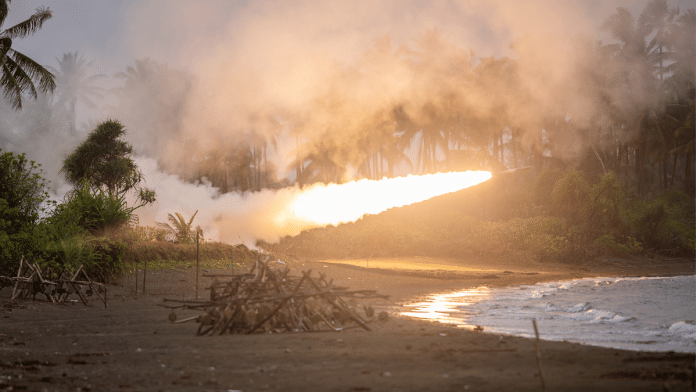New Delhi: Fuelled by the Russia-Ukraine, Israel-Hamas conflicts among other tensions worldwide, American defence companies clocked 50 percent of the global military sales in 2023, up by 2.5 percent from the previous year, according to a Stockholm International Peace Research Institute (SIPRI) report.
The Americans sold arms and ammunition worth $317 billion in 2023.
Overall, the arms revenues of the SIPRI Top 100 defence companies clocked an increase of 4.2 percent compared with that of 2022. Revenues from the global arms industry soared to $632 billion in 2023.
Next after the Americans are the Chinese companies, which did business of $103 billion with a share of 16 percent in the arms market. Incidentally, the US and China are the top two highest military spenders globally.
India ranks the lowest among major countries in the world, with the aggregate arms revenues of its three defence companies—the state-run Hindustan Aeronautics Ltd, Bharat Electronics Ltd and Mazagon Docks Ltd—in the Top 100 rising up by 5.8 percent to $ 6.7 billion in 2023.
But, the country-wise share of these three companies is a mere 1.1 percent of the total arms sale in 2023.
One of the reasons for the US’ increase in its arms revenue could be due to the Russia-Ukraine conflict. The Department of Defense (DoD) saw a ‘huge’ increase in military sales since the Ukraine invasion. In 2023, according to the DoD, the US set a record for sales of military equipment and hardware, especially among European partners and allies.
Overall, the report notes that around a quarter of the global companies in the SIPRI Top 100, are involved in activities related to nuclear weapon programmes around the world.
The 41 companies based out of the US alone, increased their arms revenues by $317 billion in 2023 (2.5 percent). The top five American companies are Lockheed Martin Corp., RTX, Northrop Grumman Corp., Boeing and General Dynamics Corp. However, Lockheed Martin and RTX, the top two companies, recorded real-terms decreases of -1.6 percent and -1.3 percent, respectively.
The reasons behind the decrease, the report states, is that despite higher demand for their weapons and military equipment, the companies struggled to ramp up production capacity due to persistent supply chain challenges in key segments such as aeronautical and missile defence.
In the case of China, nine companies—AVIC, NORINCO, CETC, CASC, CSSC, CASIC, AECC, CSGC and CNNC—were listed in the Top 100. Three of them made it to the top 10 list.
Of the Top 100 companies, 73 recorded a year-on-year growth compared to 47 in 2022. This was a result of the ‘strong increase in demand for weapons and military equipment fuelled by heightened global geopolitical tensions’, according to the SIPRI report, ‘Top 100 Arms Producing and Military Services Companies, 2023’.
Another outcome of the global conflicts, especially the Russia-Ukraine conflict, has been that many big companies manufacturing complex weapon systems grappled with not only the ongoing supply chain disruptions but also the resultant higher costs such as reduced access to raw materials.
The US is in the middle of a number of high-end projects which includes a comprehensive nuclear modernisation programme worth at least $1.5 trillion.
The aim is to replace or upgrade nearly every component of the American nuclear forces, including intercontinental ballistic missiles (ICBMs), nuclear-powered ballistic missile submarines (SSBNs), strategic bomber aircraft and nuclear warheads. Northrop Grumman is producing the new fleet of 650 ICBMs and at least 100 next generation (B21) strategic bombers. The ICBMs will be armed with new nuclear warheads, partly designed by Sandia National Laboratories.
Upgrades for some of the existing strategic bombers will have engines of Rolls Royce and radars of RTX. General Dynamics and HII are producing at least 12 SSBNs to replace the current US fleet, according to the report.
On the other hand, China is modernising all three components (air, land and sea-based forces) of its nuclear triad. AVIC produces nuclear-capable, air-to-air refuellable bomber, which was first fielded in 2020; CASC manufactures the new mobile, solid-fuelled ICBMs that are replacing the ageing silo-based, liquid-fuelled missiles.
CASC also makes the missiles used on the fleet of six SSBNs built by CSSC. CSSC is also responsible for constructing China’s next-generation SSBNs, the study says. Meanwhile, CNNC provides nuclear technology and power for military applications.
(Edited by Tony Rai)
Also Read: Navy to ink Rafale M & additional Scorpene submarines deal by next month, says Navy chief







We frequently use the term conflict of interest for persons in power. But the greatest misfortune of democratic World order has been the dirty rise of military industrial complex calling the shots in US polity.